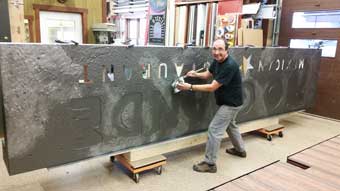When one thinks about channel letters and LED lighting, high-density urethane (HDU) might not be the material of choice that immediately springs to mind.
However award-winning House of Signs in Frisco, Colorado, recently combined DUNA-USA’s CORAFOAM® HDU with LED lighting to create an “ultra-dimensional” fascia sign for a new Rio Grande Mexican restaurant that was opening up in town.
The owners of the Rio Grande restaurants bill its eateries as “seriously good Mexican food” (their catchphrase, “Ain’t Life Grande?”), and they’ve proven successful at their other locations all across the state of Colorado.
Another Rio Grande was getting ready to open its doors as part of a new commercial center in Frisco, and the owners turned to House of Signs for outdoor identity signage ideas. “We had developed the sign criteria and standards for the entire center and therefore had been selected as the preferred vendor,” says Roger Cox, owner of House of Signs.
However each of the other Rio Grande locations featured inconsistent branding, so the owners really had little idea what they were looking for here.
For Cox, this proved to be an open menu of signage choices. “We took cues from some of the finishes inside the restaurant such as the steel background with bolts found in the bar area, as well as incorporated their logo,” he says.

Founded in 1989, House of Signs is an impressive operation located at the base of the Rocky Mountains, having won multiple awards for their custom creations. This talented team of sign makers combine traditional techniques with state-of-the-art equipment and unbridled design creativity to dream up and build signs for area businesses, public facilities, and open space venues.
House of Signs created the concept for Rio Grande and even went one extra step by fabricating an actual large prototype featuring elements of the sign (the “R” and “Mex” letters, vinyl stripe, background panel texture, etc.) for the client to review the idea. “This was an immediate sell at that point,” says Cox.
House of Signs has been using CORAFOAM HDU for about a year-and-a-half now, finding it’s easier to control when hand-carving and appears to be much less porous.
“We prefer using HDU for our channel letters instead of metal because we can achieve an additional dimensional layer with HDU,” says Cox. “This makes the sign more unique and eliminates the somewhat sterile appearance of traditional channel letters.”
The sign makers cut the sign background from twenty-pound CORAFOAM HDU on their Gerber Sabre 408 CNC router using Vectric Aspire software.
The letters were also CNC-cut from twenty-pound CORAFOAM, and each houses a string of LED lights. “Each of these custom letters was made with an interlocking design,” describes Cox. “We used acrylic push-throughs, gold stepped down accents, and black returns [to end up with these] very high-end channel letters.”
House of Signs used high-quality Sherwin-Williams™, Modern Masters, and Ronan acrylic paints throughout the sign. For the back panel of the sign, Cox utilized a glaze technique he learned after attending one of Dan Sawatzky’s well-known workshops, which was perfected by Periandros Damoulis, senior designer and fabricator at House of Signs.

This custom glaze is comprised of ten different colors. “The base coat featured about eight different colors to create the variegated patina-effect,” explains Cox. “Then we added black glaze to the entire background to give depth and soften the color transitions.”
House of Signs added green and gold 3M translucent film to the letter faces and as accent stripes.
The main body of the sign measures 4-by-19 feet, while the top crown of it measures 8 inches-by-20 feet. The HDU letters are twenty-two inches tall, and the acrylic push-thrus are seven inches tall.
The star was carved from one-inch clear acrylic with a prismatic effect and painted with metallic gold.
Part of the agreement with the city was to make the sign look like it was part of the original architecture of the building and not an add-on.
“This required meticulous field measurements and the need for a custom L-shaped armature to attach the sign to the building (and house the storage components for the power supplies),” says Cox.
House of Signs custom-welded the steel sub-structure of this armature from square tubing with a Miller 235 mig welder. “We then sheathed this frame with plywood and aluminum,” says Cox.
For Cox, incorporating LED with HDU is one of the ways House of Signs remains a leader in innovation.
—Additonal reporting provided by Brad Burnett











